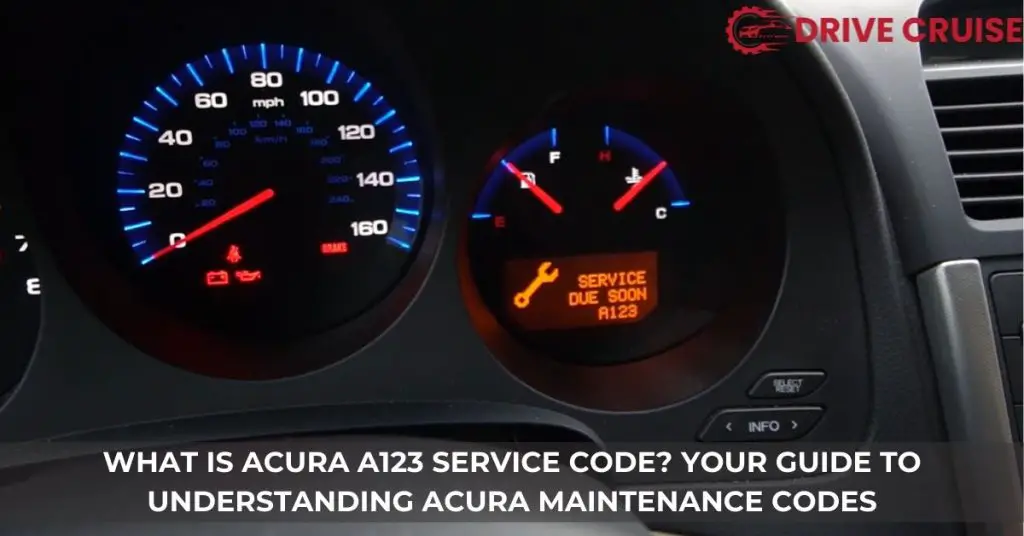Have you ever found yourself scratching your head at the sight of an Acura A123 service code popping up on your dashboard? You’re not alone. It’s like your car is trying to communicate with you in a secret language. But don’t worry, we’re here to decode that message and make sense of what your vehicle is trying to tell you.
Understanding the Acura A123 service code is crucial for keeping your car in tip-top shape. It’s a friendly reminder from your car about the maintenance it needs, but deciphering what each letter and number means can be a bit of a puzzle. Let’s dive into what this service code entails and why it’s important for your Acura’s health and longevity. Trust us, it’s simpler than it seems, and we’ll guide you through every step of the way.
Understanding the Acura Service Code System
Deciphering an Acura service code, such as A123, might initially seem daunting, but it’s essentially a streamlined way Acura communicates essential maintenance needs directly through your dashboard. This system aids in eliminating the guesswork, ensuring that we maintain our vehicles efficiently and effectively.
The Acura Service Code System is divided into two primary categories: the Main Codes and the Sub Codes. Main Codes, represented by letters, highlight generalized service areas. For example, “A” refers to an oil change, while “B” suggests a more comprehensive checkup that includes inspecting various vehicle components like brakes and possibly changing oil. These codes signify routine checks that help keep your Acura in optimal condition.
Sub Codes, on the other hand, represented by numbers, provide specific details about additional services required. Ranging from 1 to 6, these codes can indicate a variety of tasks. For instance, “1” means it’s time to rotate the tires, “2” signals replacing the air cleaner element, and “3” directs attention to transmission fluid replacement. Each number corresponds to a particular maintenance task that, although might seem minor on its own, plays a crucial role in the overall health and longevity of your Acura.
Together, these main and sub codes form a comprehensive guide tailored to your vehicle’s requirements. When we encounter a combination like A123 on our dashboard, we can quickly determine the vehicle needs an oil change, tire rotation, air cleaner element replacement, and transmission fluid replacement. By adhering to these recommendations, we ensure our Acura receives the specific care it needs, when it needs it, thereby preserving its performance and reliability over time.
Decoding the A123 Service Code
Let’s dive into the specifics of the A123 service code for Acura vehicles. This code plays a critical role in keeping your car running smoothly. When you see A123 appear on your dashboard, it’s a call to action, signaling that your vehicle requires a specific combination of services to maintain its performance and reliability.
The “A” in A123 pertains to an oil change, one of the most fundamental and essential maintenance tasks. Regular oil changes using the manufacturer’s recommended oil type keep your engine running efficiently, prevent overheating, and ensure longevity.
Following “A”, the first “1” indicates the need for a tire rotation. This service involves moving the tires to different positions on the vehicle, promoting even tire wear, and extending the life of your tires. It also helps maintain traction, ensuring a safer driving experience.
The “2” in the code signifies the replacement of the air cleaner element. The air cleaner element, or air filter, blocks out dust, dirt, and other pollutants from entering your engine. Replacing this filter at regular intervals prevents contaminants from affecting your engine’s performance and ensures optimal air-fuel mixture for efficient combustion.
Lastly, the “3” highlights the need for replacing the transmission fluid. This fluid serves as a lubricant and coolant for your vehicle’s transmission, ensuring smooth gear shifts and prolonging the transmission’s life. Over time, the fluid degrades and needs replacement to maintain the transmission’s efficiency and prevent potential damage.
By responding to the A123 service code promptly, you’re taking proactive steps to ensure your Acura remains in top condition. Regular maintenance, as indicated by these service codes, not only benefits your vehicle’s performance but also contributes to its longevity and reliability, ensuring peace of mind on the road.
Importance of the A123 Service for Your Acura
Maintaining the health of your Acura involves more than just addressing issues as they arise. Regular maintenance, such as the A123 service, plays a pivotal role in ensuring your vehicle operates at its optimal level. This service, encompassing an oil change, tire rotation, air cleaner element replacement, and transmission fluid replacement, is integral for several reasons.
First, the oil change, marked by “A”, ensures that your engine runs smoothly. Over time, oil breaks down and becomes contaminated, which can lead to engine damage. Fresh oil lubricates and cools the engine components, reducing wear and tear.
The “1” in the A123 service stands for tire rotation. Tires wear unevenly due to different weights and functions across the vehicle. Rotating them helps extend their life, maintain balanced handling, and ensure safety on the road.
Replacing the air cleaner element, represented by “2”, is crucial for maintaining engine efficiency. A clean air filter allows for optimal air flow to the engine, improving fuel economy and reducing emissions.
Lastly, the “3” indicates a transmission fluid replacement. Fresh transmission fluid is essential for the smooth operation of gear shifts and maintaining the health of the transmission system. Over time, the fluid degrades, which can lead to costly repairs if not addressed.
By adhering to the A123 service code, you not only enhance your Acura’s performance but also contribute to its longevity, reliability, and resale value. Proactive maintenance mitigates the risk of major repairs and ensures that your Acura remains a dependable companion on the road.
When to Schedule Your A123 Service
Following the explanation of the Acura A123 service code’s significance in maintaining vehicle health and ensuring optimal performance, it’s crucial to know the best time to schedule this service. Acura recommends adhering to the Maintenance Minder system, which alerts drivers when service is due, ensuring your vehicle remains in peak condition. However, understanding a general timeline can help anticipate these needs and prepare accordingly.
The A123 service code appears based on a combination of mileage and onboard computer calculations that assess driving conditions, habits, and vehicle usage. Generally, owners might see this code illuminate around the 15,000 to 25,000-mile mark, but this can vary widely.
- Oil Changes: The “A” in A123 signifies the need for an oil change. Typically, Acura suggests getting an oil change every 5,000 to 7,500 miles, but the exact timing can depend on your driving style and conditions. If you frequently drive in demanding conditions, you may need an oil change sooner.
- Tire Rotations: Tire rotations, indicated by “1” in the code, should happen with every oil change or at least every 7,500 miles. Regular rotations ensure even tire wear and extend the life of your tires.
- Air Cleaner Element Replacement: The “2” stands for replacing the air cleaner element, a service usually recommended every 15,000 miles. This ensures your engine “breathes” clean air, maintaining fuel efficiency and performance.
- Transmission Fluid Replacement: Lastly, “3” marks the transmission fluid replacement. This is typically advised every 30,000 miles to ensure smooth gear shifts and the longevity of the transmission system.
If you frequently encounter severe weather or drive in challenging conditions, consider scheduling your A123 service earlier than the suggested intervals. Maintaining a proactive approach to vehicle maintenance, as represented by the A123 service code, guarantees the reliability, longevity, and performance of your Acura.
Preparing for Your A123 Service Appointment
After understanding when to schedule the A123 service and its importance for your Acura’s performance and longevity, preparing for the service appointment is the next step. Here’s how you can ensure a smooth and efficient experience at the dealership or service center.
Gather Relevant Documents
Before heading to your appointment, make sure to gather all necessary documents. These include your vehicle’s service history, warranty information, and any previous A123 service records if applicable. Having these documents on hand helps your technician better understand your vehicle’s maintenance needs.
Check Your Vehicle
Perform a quick check of your Acura to note any specific issues you might want to address during the service appointment. Whether it’s a strange noise, a dashboard warning light, or anything out of the ordinary, mentioning these observations to your technician can lead to more comprehensive service.
Clean Out Your Vehicle
Service technicians may need access to different parts of your Acura, including the trunk or glove compartment, to perform some of the A123 services. Removing personal items ensures they can work efficiently without navigating around your belongings.
Plan for Transportation
Depending on the scope of the A123 service, your vehicle might need to stay at the service center for a few hours or possibly the entire day. Arrange for alternative transportation in advance, whether it’s a ride from a friend, a rental car, or utilizing the dealer’s shuttle service if available.
Ask About Service Specials
Service centers often offer promotions or specials on maintenance packages. When scheduling your appointment, inquire about any current deals for the A123 service to potentially save money on your visit.
By taking these steps, you can make your A123 service appointment a hassle-free experience, ensuring your Acura receives the care it needs for optimal performance and longevity.
Conclusion
We’ve walked through the essentials of the Acura A123 service code and how it plays a pivotal role in keeping our vehicles in top shape. By understanding what this service entails and preparing accordingly for our appointments, we’re setting the stage for a hassle-free experience that not only ensures our Acura’s performance but also its longevity. Let’s not overlook the importance of these routine checks and maintenance tasks. They’re the backbone of a reliable ride that keeps us safe and sound on the road. So here’s to taking care of our Acuras with the attention and care they deserve. After all, it’s not just about maintaining a car; it’s about preserving the joy and freedom that comes with driving it.
Related Posts:
- What is Acura A12 Service Code? A Friendly Guide to Understanding Your Vehicle’s Maintenance Needs
- What is Acura A13 Service Code: A Friendly Guide
- What is Acura A123 Service Code? Your Guide to Understanding Acura Maintenance Codes
- What is Acura B12 Service Code? A Beginner’s Guide
- What is Acura B13 Service Code: A Quick Guide
- What is Acura B123 Service Code? A Friendly Guide to Understanding Your Acura’s Maintenance Needs
- What is Acura B135 Service Code: Everything You Need to Know







